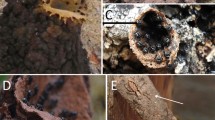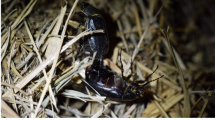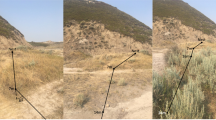Abstract
Several species of neotropical ants direct their aerial descent toward tree trunks during a fall from the forest canopy. The primary goal of this study was to determine if afrotropical arboreal ants exhibit similar gliding behavior. Ants were collected from nine tree crowns in late secondary forest at a hydrocarbon extraction site near Gamba, Gabon. Of the 32 species tested, the behavior was observed in five Cataulacus spp. and three Camponotus spp., making this the first report of gliding in African ants. Aerial glide performance (horizontal distance traveled per unit vertical drop distance) decreased with increasing body size among species and among individuals of Cataulacus erinaceus. Characteristics of directed descent behavior in C. erinaceous were very similar to those of the neotropical ant Cephalotes atratus.


Similar content being viewed by others
References
Alonso A, Lee ME, Campbell P, Pauwels OSG, Dallmeier F (eds) (2006) Gamba, Gabon: biodiversity of an equatorial African rainforest. Bull Biol Soc Wash., No. 12. National Museum of Natural History, Washington, DC
Brady SG, Schultz TR, Fisher BL, Ward PS (2006) Evaluating alternative hypotheses for the early evolution and diversification of ants. Proc Natl Acad Sci USA 103:18172–18177
de Andrade ML, Baroni Urbani C (1999) Diversity and adaptation in the ant genus Cephalotes, past and present. Stutt. Beitr. Natur., Ser. B (Geol. Paläontol.), no. 271. Stuttgart Museum of Natural History, Stuttgart
Fisher BL (ed) (2004) Monts Doudou, Gabon: a floral and faunal inventory with reference to elevational variation. Mem. Calif. Acad. Sci., no. 28. California Academy of Sciences, San Francisco
Haemig PD (1997) Effects of birds on the intensity of ant rain: a terrestrial form of invertebrate drift. Anim Behav 54:89–97
Kingsolver JG, Koehl MAR (1994) Selective factors in the evolution of insect wings. Annu Rev Entomol 39:425–451
Laurance WF, Croes BM, Tchignoumba L, Lahm SA, Alonso A, Lee ME, Campbell P, Ondzeano C (2006) Impacts of roads and hunting on central African rainforest mammals. Conserv Biol 20:1251–1261
Longino JT, Colwell RK (1997) Biodiversity assessment using structured inventory: capturing the ant fauna of a tropical rain forest. Ecol Applic 7:1263–1277
Moreau CS, Bell CD, Vila R, Archibald SB, Pierce NE (2006) Phylogeny of the ants: diversification in the age of angiosperms. Science 312:101–104
Perry DR (1978) A method of access into the crowns of emergent and canopy trees. Biotropica 10:155–157
SAS Institute (2002) SAS OnlineDoc 9. SAS Institute, Cary, NC
Sokal RR, Rohlf FJ (1995) Biometry, 3rd edn. Freeman, New York
Taylor B (2006) The ants of (sub-Saharan) Africa (Hymenoptera: Formicidae), 8th edn. http://antbase.org/ants/africa/
Thibault M, Fisher BL, Goodman SM (2004) Description of Monts Doudou, Gabon, and the 2000 biological inventory of the reserve. In: Fisher BL (ed) Monts Doudou, Gabon: a floral and faunal inventory with reference to elevational variation. Mem. Calif. Acad. Sci., no. 28, pp. 3–15
Ward PS, Downie DA (2005) The ant subfamily Pseudomyrmecinae (Hymenoptera: Formicidae): phylogeny and evolution of big-eyed arboreal ants. Syst Entomol 30:310–335
Weber NA (1957) The nest of an anomalous colony of the arboreal ant Cephalotes atratus. Psyche 64:60–69
Yanoviak SP, Dudley R, Kaspari M (2005) Directed aerial descent in canopy ants. Nature 433:624–626
Yanoviak SP, Dudley R (2006) The role of visual cues in directed aerial descent of Cephalotes atratus workers (Hymenoptera: Formicidae). J Exper Biol 209:1777–1783
Yanoviak SP, Fisher B, Alonso A (2007) Arboreal ant diversity (Hymenoptera: Formicidae) in a central African forest. Afr J Ecol 46:60–66
Acknowledgements
F. Dallmeier, A. Honorez, O.S.G. Pauwels, M. Lee, and T. Pacheco provided logistical support. Comments from R. Dudley and M. Kaspari improved the manuscript. A. Henderson, A. Mikheyev, G. Moussavou, and E. Tobi assisted in the field. We thank Shell Gabon for allowing us to conduct research within the concession and the Secrétariat Général of Gabon for providing collection and export permits. This research was supported in part by the National Geographic Society and the National Zoological Park. This paper is contribution #81 of the Gabon Biodiversity Program.
Author information
Authors and Affiliations
Corresponding author
Rights and permissions
About this article
Cite this article
Yanoviak, S.P., Fisher, B.L. & Alonso, A. Directed Aerial Descent Behavior in African Canopy Ants (Hymenoptera: Formicidae). J Insect Behav 21, 164–171 (2008). https://doi.org/10.1007/s10905-008-9116-5
Revised:
Accepted:
Published:
Issue Date:
DOI: https://doi.org/10.1007/s10905-008-9116-5




